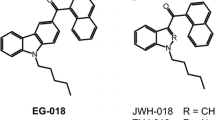Abstract
Since the federal authorities scheduled the first synthetic cannabinoids, JWH-018 and JWH-073, new synthetic cannabinoids were robustly marketed. N-(1-Adamantyl)-1-pentylindazole-3-carboxamide (AKB-48), also known as APINACA, was recently observed in Japanese herbal smoking blends. The National Forensic Laboratory Information System registered 443 reports of AKB-48 cases in the USA from March 2010 to January 2013. In May 2013, the Drug Enforcement Administration listed AKB-48 as a Schedule I drug. Recently, AKB-48 was shown to have twice the CB1 receptor binding affinity than CB2. These pharmacological effects and the difficulty in detecting the parent compound in urine highlight the importance of metabolite identification for developing analytical methods for clinical and forensic investigations. Using human hepatocytes and TripleTOF mass spectrometry, we identified 17 novel phase I and II AKB-48 metabolites, products of monohydroxylation, dihydroxylation, or trihydroxylation on the aliphatic adamantane ring or N-pentyl side chain. Glucuronide conjugation of some mono- and dihydroxylated metabolites also occurred. Oxidation and dihydroxylation on the adamantane ring and N-pentyl side chain formed a ketone. More metabolites were identified after 3 h of incubation than at 1 h. For the first time, we present a AKB-48 metabolic scheme obtained from human hepatocytes and high-resolution mass spectrometry. These data are needed to develop analytical methods to identify AKB-48 consumption in clinical and forensic testing.








Similar content being viewed by others
Abbreviations
- AKB-48:
-
N-(1-Adamantyl)-1-pentylindazole-3-carboxamide
- CB:
-
Cannabinoid
- cps:
-
Counts per second
- CYP:
-
Cytochrome P450
- IDA:
-
Information-dependent acquisition
- LC-MS:
-
Liquid chromatography mass spectrometry
- MDF:
-
Mass defect filter
- MW:
-
Molecular weight
- NFLIS:
-
National Forensic Laboratory Information System
- THC:
-
Delta 9-tetrahydrocannabinol
- TOF:
-
Time of flight
- UDPGT:
-
Uridine diphosphate glucuronosyltransferase
- XICs:
-
Extracted ion chromatograms
References
Dresen S, Ferreiros N, Putz M, Westphal F, Zimmermann R, Auwarter V. Monitoring of herbal mixtures potentially containing synthetic cannabinoids as psychoactive compounds. J Mass Spectrom. 2010;45(10):1186–94.
Wilson RI, Nicoll RA. Endocannabinoid signaling in the brain. Science. 2002;296(5568):678–82.
Auwarter V, Dresen S, Weinmann W, Muller M, Putz M, Ferreiros N. ‘Spice’ and other herbal blends: harmless incense or cannabinoid designer drugs? J Mass Spectrom. 2009;44(5):832–7.
Lindigkeit R, Boehme A, Eiserloh I, Luebbecke M, Wiggermann M, Ernst L, et al. Spice: a never ending story? Forensic Sci Int. 2009;191(1–3):58–63.
Uchiyama N, Kikura-Hanajiri R, Ogata J, Goda Y. Chemical analysis of synthetic cannabinoids as designer drugs in herbal products. Forensic Sci Int. 2010;198(1–3):31–8.
Wikstrom M, Thelander G, Dahlgren M, Kronstrand R. An accidental fatal intoxication with methoxetamine. J Anal Toxicol. 2013;37(1):43–6.
Thornton SL, Wood C, Friesen MW, Gerona RR. Synthetic cannabinoid use associated with acute kidney injury*. Clin Toxicol (Phila). 2013;51(3):189–90.
Kneisel S, Auwarter V, Kempf J. Analysis of 30 synthetic cannabinoids in oral fluid using liquid chromatography-electrospray ionization tandem mass spectrometry. Drug Test Anal. 2013 (in press).
Hutter M, Kneisel S, Auwarter V, Neukamm MA. Determination of 22 synthetic cannabinoids in human hair by liquid chromatography-tandem mass spectrometry. J Chromatogr B Analyt Technol Biomed Life Sci. 2012;903:95–101.
Yanes EG, Lovett DP. High-throughput bioanalytical method for analysis of synthetic cannabinoid metabolites in urine using salting-out sample preparation and LC-MS/MS. J Chromatogr B Analyt Technol Biomed Life Sci. 2012;909:42–50.
Shanks KG, Dahn T, Terrell AR. Detection of JWH-018 and JWH-073 by UPLC-MS-MS in postmortem whole blood casework. J Anal Toxicol. 2012;36(3):145–52.
Kneisel S, Speck M, Moosmann B, Corneillie TM, Butlin NG, Auwarter V. LC/ESI-MS/MS method for quantification of 28 synthetic cannabinoids in neat oral fluid and its application to preliminary studies on their detection windows. Anal Bioanal Chem. 2013;405:4691–706.
Wohlfarth A, Scheidweiler KB, Chen X, Liu HF, Huestis MA. Qualitative confirmation of 9 synthetic cannabinoids and 20 metabolites in human urine using LC-MS/MS and library search. Anal Chem. 2013;85(7):3730–8.
de Jager AD, Warner JV, Henman M, Ferguson W, Hall A. LC-MS/MS method for the quantitation of metabolites of eight commonly-used synthetic cannabinoids in human urine—an Australian perspective. J Chromatogr B Analyt Technol Biomed Life Sci. 2012;897:22–31.
Usami N, Okuda T, Yoshida H, Kimura T, Watanabe K, Yoshimura H, et al. Synthesis and pharmacological evaluation in mice of halogenated cannabidiol derivatives. Chem Pharm Bull (Tokyo). 1999;47(11):1641–5.
Moller I, Wintermeyer A, Bender K, Jubner M, Thomas A, Krug O, et al. Screening for the synthetic cannabinoid JWH-018 and its major metabolites in human doping controls. Drug Test Anal. 2011;3(9):609–20.
Hutter M, Broecker S, Kneisel S, Auwarter V. Identification of the major urinary metabolites in man of seven synthetic cannabinoids of the aminoalkylindole type present as adulterants in ‘herbal mixtures’ using LC-MS/MS techniques. J Mass Spectrom. 2012;47(1):54–65.
Sobolevsky T, Prasolov I, Rodchenkov G. Detection of urinary metabolites of AM-2201 and UR-144, two novel synthetic cannabinoids. Drug Test Anal. 2013 (in press).
Uchiyama N, Kawamura M, Kikura-Hanajiri R, Goda Y. URB-754: a new class of designer drug and 12 synthetic cannabinoids detected in illegal products. Forensic Sci Int. 2013;227(1–3):21–32.
Grigoryev A, Kavanagh P, Melnik A. The detection of the urinary metabolites of 3-[(adamantan-1-yl)carbonyl]-1-pentylindole (AB-001), a novel cannabimimetic, by gas chromatography–mass spectrometry. Drug Test Anal. 2012;4(6):519–24.
Wintermeyer A, Moller I, Thevis M, Jubner M, Beike J, Rothschild MA, et al. In vitro phase I metabolism of the synthetic cannabimimetic JWH-018. Anal Bioanal Chem. 2010;398(5):2141–53.
Seely KA, Brents LK, Radominska-Pandya A, Endres GW, Keyes GS, Moran JH, et al. A major glucuronidated metabolite of JWH-018 is a neutral antagonist at CB1 receptors. Chem Res Toxicol. 2012;25(4):825–7.
Chimalakonda KC, Bratton SM, Le VH, Yiew KH, Dineva A, Moran CL, et al. Conjugation of synthetic cannabinoids JWH-018 and JWH-073, metabolites by human UDP-glucuronosyltransferases. Drug Metab Dispos. 2011;39(10):1967–76.
Acknowledgments
This research was supported by the Intramural Research Program of the National Institute on Drug Abuse, National Institutes of Health.
Conflict of Interest
None
Author information
Authors and Affiliations
Corresponding author
Rights and permissions
About this article
Cite this article
Gandhi, A.S., Zhu, M., Pang, S. et al. First Characterization of AKB-48 Metabolism, a Novel Synthetic Cannabinoid, Using Human Hepatocytes and High-Resolution Mass Spectrometry. AAPS J 15, 1091–1098 (2013). https://doi.org/10.1208/s12248-013-9516-0
Received:
Accepted:
Published:
Issue Date:
DOI: https://doi.org/10.1208/s12248-013-9516-0




